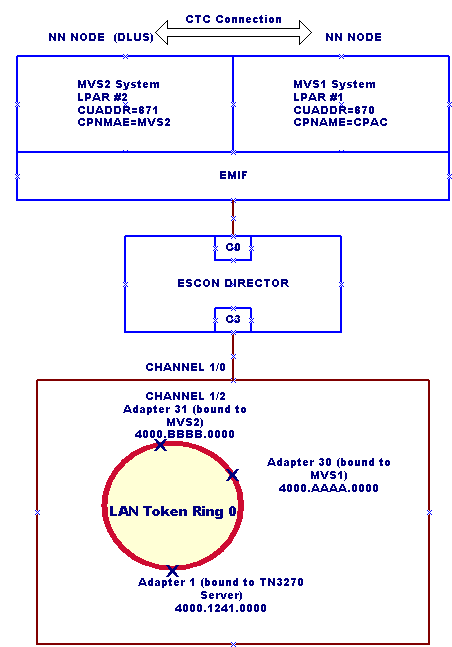Comutação de sessão com DLUR e DLUS usando links estáticos e PUs dinâmicas
Contents
Introduction
Este documento fornece uma configuração de exemplo para um servidor Cisco TN3270 que está usando comutação de sessão com um Dependent Logical Unit Requester (DLUR) e um Dependent Logical Unit Server (DLUS) que está usando links estáticos e Unidades Físicas dinâmicas (PUs).
Prerequisites
Requirements
Não existem requisitos específicos para este documento.
Componentes Utilizados
Este documento não se restringe a versões de software e hardware específicas.
The information in this document was created from the devices in a specific lab environment. All of the devices used in this document started with a cleared (default) configuration. If your network is live, make sure that you understand the potential impact of any command.
Conventions
Para obter mais informações sobre convenções de documento, consulte as Convenções de dicas técnicas Cisco.
Configurar
Nesta seção, você encontrará informações para configurar os recursos descritos neste documento.
Observação: para encontrar informações adicionais sobre os comandos usados neste documento, use a ferramenta Command Lookup Tool (somente clientes registrados).
Diagrama de Rede
Este documento utiliza a seguinte configuração de rede:

Configuração
Isso está em vigor para esta configuração de exemplo:
-
Duas partições lógicas (LPARs) que estão executando o MVS (Multiple Virtual Storage, Armazenamento virtual múltiplo) em um mainframe de EmIF (Multiple Image Facility, instalação de várias imagens) do Enterprise System Connection (ESCON):
-
LPAR nº 1: Sistema MVS1. Esse sistema deve ser configurado apenas como um nó de rede (NN).
-
LPAR nº 2: Sistema MVS2. Esse sistema deve ser configurado como um NN e um DLUS principal.
-
-
Nenhum subsistema APPN (Advanced Peer-to-Peer Networking) no roteador, exceto o DLUR do servidor Cisco TN3270, que é usado como um nó final.
-
O endereço IP de escuta do servidor Cisco TN3270 172.26.19.99 conectado ao DLUS (MVS2).
-
Links estáticos configurados no Cisco TN3270 Server DLUR para conexão com o MVS1 e o MVS2.
-
MVS1 conectado ao MVS2 através do link Channel To Channel (CTC).
-
Conexão Ponto de Controle para Ponto de Controle (CP-CP) estabelecida entre MVS1 e MVS2 sobre o link CTC via MPC (Multi-Path Channel, canal de multi-caminho). (As definições de Transport Resource List [TRL] e LOCAL Major Node são necessárias em MVS1 e MVS2.)
Este documento utiliza as seguintes configurações:
| Configuração do roteador |
|---|
!
version 11.2
service udp-small-servers
service tcp-small-servers
!
interface TokenRing0/0
ip address 172.26.7.16 255.255.255.0
ring-speed 16
!
interface Channel1/0
csna C010 70
!--- This is the Cisco Systems Network Architecture (SNA) connection to MVS1.
csna C020 71
!--- This is the Cisco SNA connection to MVS2.
!
interface Channel1/2
ip address 172.26.19.98 255.255.255.224
no keepalive
lan TokenRing 0
adapter 1 4000.1241.1000
!--- This is bound to the TN3270 server.
adapter 30 4000.aaaa.0000
!--- This is bound to the MVS1 Cisco SNA connection.
adapter 31 4000.bbbb.0000
!--- This is bound to the MVS2 Cisco SNA connection.
tn3270-server
dlur NETA.WALL NETA.MVS2
!--- The DLUR: NETA.WALL and the DLUS: NETA.MVS2.
lsap token-adapter 1
link CPAC lsap C0 rmac 4000.aaaa.0000 rsap 04
link MVS2 lsap C0 rmac 4000.bbbb.0000 rsap 04
pu dlurpup eeeeffff 172.26.19.99
!
router eigrp 109
network 172.26.0.0
!
line con 0
exec-timeout 0 0
line aux 0
line vty 0 4
password cisco
login
!
end |
| Nó principal XCA em MVS1: XCAMVS1 |
|---|
MVS1870 VBUILD TYPE=XCA
PR870 PORT ADAPNO=30,CUADDR=870,SAPADDR=04,MEDIUM=RING,TIMER=60
*
GRP870 GROUP ANSWER=ON, X
AUTOGEN=(5,U,P), X
CALL=INOUT, X
DIAL=YES, X
DYNPU=YES, X
DYNPUFX=CN, X
ISTATUS=ACTIVE |
| Nó principal XCA em MVS2: XCAMVS2 |
|---|
MVS871 VBUILD TYPE=XCA
PR871 PORT ADAPNO=31,CUADDR=871,SAPADDR=04,MEDIUM=RING,TIMER=60
*
GRP871 GROUP ANSWER=ON, X
AUTOGEN=(5,U,P), X
CALL=INOUT, X
DIAL=YES, X
DYNPU=YES, X
DYNPUPFX=CN, X
ISTATUS=ACTIVE |
| Nó principal da LU em MVS2: LUCPCP |
|---|
LUGRL VBUILD TYPE=LUGROUP
DLUSYED LUGROUP
327802 LU DLOGMOD=D4C32782,LOGAPPL=NETTESTR, X
MODETAB=ISTINCLM,USSTAB=USSL3270,SSCPFM=USS3270
327804E LU DLOGMOD=D4C32784,LOGAPPL=NETTESTR, X
MODETAB=ISTINCLM,USSTAB=USSL3270,SSCPFM=USS3270
@ LU DLOGMOD=D4C32782,LOGAPPL=NETTMVS2, X
MODETAB=ISTINCLM,USSTAB=USSL3270,SSCPFM=USS3270
!--- The NETTESTR application is on MVS1. !--- This is specified with LOGAPPL=NETTESTR.
|
| Nó principal da rede comutada (SWNET) no MVS2: SW1TSYSP |
|---|
SW1TSYS VBUILD TYPE=SWNET
*
*
TSYSPU PU ADDR=02, X
IDBLK=EEE,IDNUM=EFFFF, X
ISTATUS=ACTIVE, X
LUGROUP=DLUSYED,LUSEED=M3270L##, X
PUTYPE=2,DLOGMOD=D4C32784,MODETAB=ISTINCLM, X
SSCPFM=USS3270,PACING=8,VPACING=8
M3270L01 LU LOCADDR=01,LOGAPPL=TSOMVS1
!--- PU TSYSPU is used for the Cisco TN3270 Server !--- session switching connection.
|
| Nó de rede TRL em MVS1 para a conexão CTC: MPCM1ICN |
|---|
************************************************************************
* MVS1 READ CUAS: A60,A70 CTC UNITAD 20,30 *
* MVS2 WRITE CUAS: B20,B30 CNC UNITAD 20,30 *
* MVS1 WRITE CUAS: B40,B50 CNC UNITAD 00,10 *
* MVS2 READ CUAS: A00,A10 CTC UNITAD 00,10 *
************************************************************************
MPCM1ICN VBUILD TYPE=TRL
MPCM1M2 TRLE LNCTL=MPC,MAXBFRU=16, X
READ=(A60,A70), X
WRITE=(B40,B50) |
| Nó principal LOCAL em MVS1 para a conexão CTC: TRLM1ICN |
|---|
TRLM1ICN VBUILD TYPE=LOCAL
* XID=YES,HPR=YES FOR NN ONLY
TRLM1PU1 PU TRLE=MPCM1M2, X
ISTATUS=ACTIVE,VPACING=0, *XID=YES,HPR=YES X
SSCPFM=USSSCS,CONNTYPE=APPN,CPCP=YES |
| Nó de rede TRL em MVS2 para a conexão CTC: MPCM2NN |
|---|
************************************************************************
* MVS1 READ CUAS: A60,A70 CTC UNITAD 20,30 *
* MVS2 WRITE CUAS: B20,B30 CNC UNITAD 20,30 *
* MVS1 WRITE CUAS: B40,B50 CNC UNITAD 00,10 *
* MVS2 READ CUAS: A00,A10 CTC UNITAD 00,10 *
************************************************************************
MPCM2NN VBUILD TYPE=TRL
MPCM2M1 TRLE LNCTL=MPC,MAXBFRU=16,
READ=(A00,A10),
WRITE=(B20,B30) |
| Nó principal LOCAL em MVS2 para a conexão CTC: TRLM2NN |
|---|
TRLM2NN VBUILD TYPE=LOCAL
******* USE XID=YES,HPR=YES IF OTHER MVS IS NN
TRLM2PU1 PU TRLE=MPCM2M1, X
ISTATUS=ACTIVE,VPACING=0, *XID=YES,HPR=YES, X
SSCPFM=USSSCS,CONNTYPE=APPN,CPCP=YES |
Verificar
No momento, não há procedimento de verificação disponível para esta configuração.
Troubleshoot
Atualmente, não existem informações disponíveis específicas sobre Troubleshooting para esta configuração.
 Feedback
Feedback